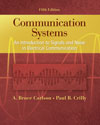
|  |
Feature Summary| New features of this fifth edition include (a) the addition of MATLAB† examples,
exercises and problems that are available on the book’s website, www.mhhe.com/
carlsoncrilly; (b) new end-of-chapter conceptual questions to reinforce the theory,
provide practical application to what has been covered, and add to the students’
problem-solving skills; (c) expanded coverage of wireless communications and an
introduction to radio wave propagation that enables the reader to better appreciate the
challenges of wireless systems; (d) expanded coverage of digital modulation systems
such as the addition of orthogonal frequency division modulation and ultra wideband
systems; (e) expanded coverage of spread spectrum; (f) a discussion of wireless networks; and (g) an easy-to-reference list of abbreviations and mathematical symbols.
Following an updated introductory chapter, this text has two chapters dealing
with basic tools. These tools are then applied in the next four chapters to analog communication systems, including sampling and pulse modulation. Probability, random
signals, and noise are introduced in the following three chapters and applied to analog
systems. An appendix separately covers circuit and system noise. The remaining six chapters are devoted to digital communication and information theory, which
require some knowledge of random signals and include coded pulse modulation.
All sixteen chapters can be presented in a yearlong undergraduate course with
minimum prerequisites. Or a one-term undergraduate course on analog communication
might consist of material in the first seven chapters. If linear systems and probability
theory are covered in prerequisite courses, then most of the last eight chapters
can be included in a one-term senior/graduate course devoted primarily to digital
communication.
The modular chapter structure allows considerable latitude for other formats.
As a guide to topic selection, the table of contents indicates the minimum prerequisites
for each chapter section. |
|
|